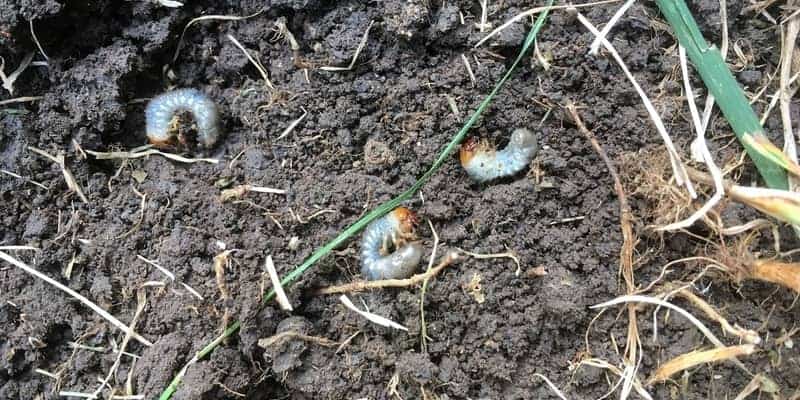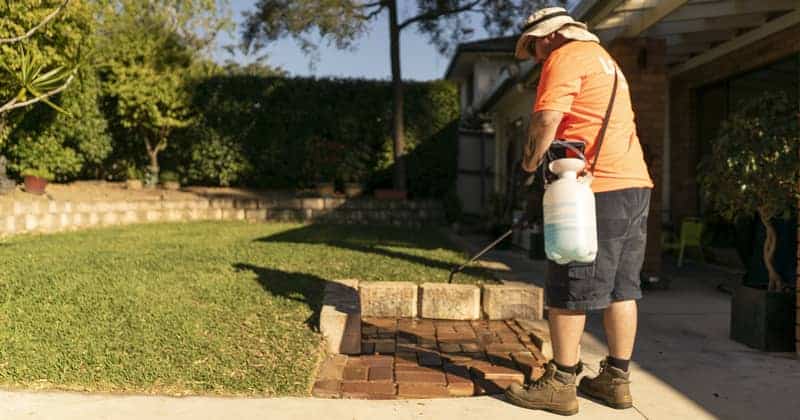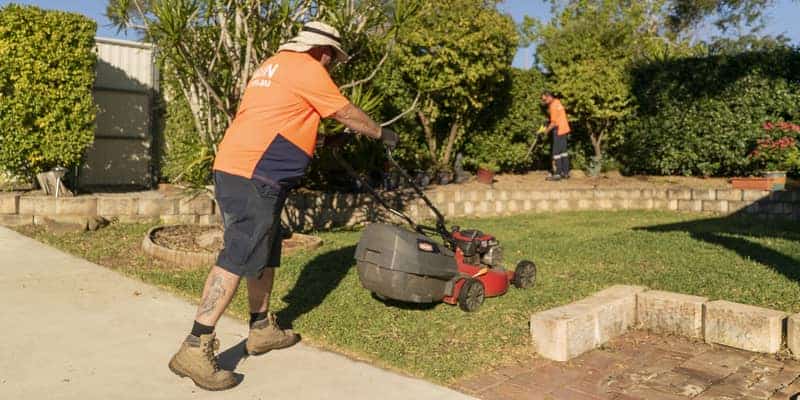It may seem pleasant to have so many birds in your yard… until you realise your turf has become the new neighbourhood snack bar.
Increased bird activity is one of the most common signs of a grub infestation, which is bad news for your lawn.
Some other common signs of a lawn grub infestation include spongey soil texture and brown patches.
To get rid of lawn grubs naturally, you can use a wet hessian bag or towel. For more severe infestations, an insecticide spray may be necessary. To prevent lawn grubs, mow your lawn high and treat it with products like Acelepryn.
If you’ve got an infestation, no need to panic. We can teach you how to get rid of grubs in lawn – and how to prevent a future lawn grub attack.
Signs of Lawn Grubs

You often don’t see lawn grubs destroying your beloved yard because they’re underground. Grubs feed on grass roots and blades, turning a healthy lawn into their personal smorgasbord.
Monitor your yard closely and check for:
- Brown or dead patches and dead grass
- Springy or spongey feel to the soil when stepped on
- Loose grass
- Increased bird or wasp activity
- Adult beetles
Common beetle larvae you can find in Australia include the African black beetle, Army worm moth, and Japanese beetle grubs.
Lawn grubs are particularly prevalent from October through March, during the warmer months. Lawn grubs love the lush, green turf that’s full of nutrients.
Besides the season, certain grass varieties are more susceptible to grubs than others.
RTF Tall Fescue, Eureka Kikuyu, and Nullarbor Couch grasses tend to attract more grubs than the Sir Walter Buffalo or TifTuf Bermuda.
Testing for Lawn Grubs
Of course, lawn discolouration could just be from winter, while sponginess could be from waterlogging.
To confirm whether lawn grubs are making a home under your turf, perform a simple test.
You’ll need:
- A bucket of soapy water (regular dish soap will do!)
- A hessian bag or old towel
Mix a bucket of soap and water.
At dusk, pour the soap solution over the area you think has lawn grubs. Cover as large an area as possible.
Layer the hessian bags or old towels over the soapy area.
Leave on the lawn overnight.
Come back at dawn and check the hessian bags. Any lawn grubs will have come to the surface and attached themselves to the hessian.
The soapy water won’t kill grubs, but it does make them emerge from their hiding spots!
How to Treat Lawn Grub Attacks
Fortunately, lawn grub treatment is very straightforward. You can get rid of lawn grubs in several ways.
1. Get rid of grubs with wet towels
If you suspect an infestation over a small area, you can reuse the same method as the grub test. Pour soapy water over the affected areas, then lay down several hessian bags.
The grubs will move towards the surface and attach themselves to the fibres.
After dawn, simply remove and dispose of the bags with the grubs. Repeat as necessary.
2. Kill grubs with insecticide
You can check your local lawn care store for products that are effective at killing grubs. Most of these are commercial, chemical insecticides that come in three forms:
- Granules
- Hose-on
- Concentrated liquid
You can go DIY or hire a local professional to handle the job. Either way, here are some helpful tips:
- Treat your lawn in the late afternoon or early evening
- Do it more than once, and space treatments by a week
- Don’t spray if it’s likely to rain, since that could cause your lawn to become waterlogged
- Still, insecticide needs watering to seep down
- Treat affected areas with a safe fertiliser a few days later
A more natural alternative to commercial/chemical insecticides is neem oil.
By applying a neem oil spray, you can act before lawn grubs turn into adult beetles – or even prevent beetles from laying eggs. You also won’t affect any beneficial nematodes in the root system.
Mix neem oil with water for an effective anti-grub treatment.
3. Milky spore disease
Milky spore is a cultivated bacteria that targets only Japanese beetles. You apply it to turf grass in dust form.
We do not recommend using milky spore disease, even with the presence of Japanese beetles.
Milky spore takes years to develop and needs a sufficient population of Japanese beetles to propagate.
It’s a better use of time and resources to use either of the two above mentioned solutions to kill lawn grubs.
Preventing Lawn Grubs
Of course, you won’t need to cure a lawn grub problem if beetles don’t lay eggs in the first place.
You won’t need a grub killer if you don’t have grubs!
1. Acelepryn treatment
Acelepryn is a commercial turf insecticide that works to control grubs.
Each application lasts six months, so you only need to apply it to your lawn twice a year for full coverage.
2. High mowing
Garden pests like beetles and moths like laying their eggs as close to the soil as possible.
Hire an expert lawn mowing service that can trim your lawn to the ideal length and monitor for any signs of lawn grub activity.
3. Lawn aeration
Aerating your lawn regularly will create a healthy, resilient root system that is more able to withstand grub attacks.
You can either use lawn coring or garden forks to aerate your soil.
4. Mindful watering
Lawn grubs thrive when soil is warm and moist, so don’t make them comfortable!
Water your lawn only as necessary – less frequently, but more deeply.
In general, curling leaves should be your sign to water your lawn.





